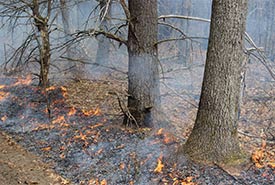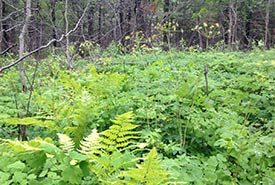Discovery of the yellow pimpernel

Prescribed burns on the Hazel Bird Nature Reserve are being used to restore native oak savannah and tall grass prairie. (Photo by NCC)
Prescribed burns are an integral part of the restoration plan for oak savannah on the Nature Conservancy of Canada’s (NCC’s) Hazel Bird Nature Reserve. As part of the burning process, NCC staff set up plots to monitor short and long-term changes in the habitats.
Many of the property’s savannah areas have not been burned in decades. In pioneer times and prior, fires had moved across uninhabited lands, maintaining the savannah. With a lack of prescribed fires, the habitat will fill in with plants, blocking out the sunlight and reducing the population of native savannah plants.
Today, fire is used as a stewardship tool on the nature reserve. Savannah seeds and plants are often suppressed by invasive and native non-savannah plant species. With prescribed burns, the populations of native, fire-adapted plant species are enhanced while other species are reduced. The burns also increase light levels at the ground level, thereby increasing the native plants.

The beautiful and delicate yellow pimpernel enjoy open woodlands that offer plenty of light. (Photo by NCC)
During a recent inventory of the property, NCC staff identified the presence of the uncommon, beautiful delicately flowered yellow pimpernel. Staff discovered that the population had increased after prescribed burns, helping to demonstrate the success of this restoration technique.
Yellow pimpernel is a member of the carrot family. This perennial plant is 30 to 90 centimetres tall and grows in open woodland and savannah habitat, where the light levels are high. Leaves are entire and alternate, with the lower leaves often double to triple compound with three to five leaflets.
The flowers, which are difficult to photograph, are small, bright yellow on delicate stalks in a grouping of 12 to 15 flowers called umbels. The plant blooms in late May to mid-June. A source of nourishment to pollinators, the pimpernel’s bright yellow flowers stand high above other woodland species.
Future burns will be planned based on the results of post-burn monitoring of the property. It is expected that the population of the yellow pimpernel and other savannah plants will increase in this unique and globally rare habitat. Staff are optimistic that new populations of savannah species will be found during future monitoring.


